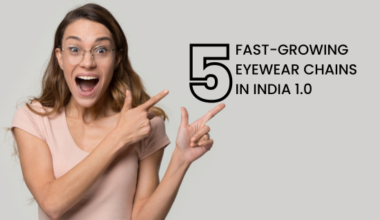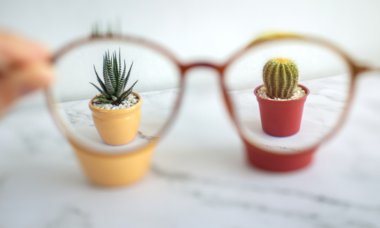Myopia, also known as nearsightedness, is a proliferating vision condition in India, mainly among children and young adults. In simple words, Myopia is the inability to view distant objects. While close objects are clear in vision, farther away, ones appear blurry.
Myopia has become more common over the past few decades due to many factors, including changes in lifestyle, excessive screen time, and a decline in outdoor activities.
These factors differ geographically and culturally. In a study conducted by the National Library of Medicine, they observed different geo-biological variations that included social factors and genetics. Genetics, too, play a significant role in myopia development, behavioral modifications can control it.
State of Myopia in India
Although myopia is a simple refractive error, it may greatly impact the quality of life. The increasing number of myopia cases in India and beyond rings alarms on our current lifestyles. It is predicted that Myopia and High Myopia will affect approximately 50% of the worldwide population by 2050. With India being the most populated country in the world (with around 41% of its population being less than 18 years of age), it has become a major concern for the country.
As discussed above, India is diverse, culturally and geographically. Therefore, the prevalence of myopia in India also differs among various states. Research Gate has prepared a comprehensive report in 2019 wherein they have classified myopia literature in six regions namely North, South, East, West, Northeast, and Central zones.
The research is quite extensive but briefly speaking here is what the state of myopia in India looks like:
- The prevalence of Myopia in the South Zone varies from 3% to 35% in different regions.
- The prevalence of Myopia in the Central Zone varies from 3% to 16%.
- The prevalence of Myopia in the East Zone varies from 0.63% to 24%.
- The prevalence of Myopia in the West Zone varies from 2% to 17%.
- The prevalence of Myopia in the North Zone varies from 2.5% to 25%
- The prevalence of Myopia in the Northeast Zone is 27.4%.
Myopia and Other Comorbidities
With higher levels of myopia, the risk of eye conditions such as retinal detachment, retinoschisis, glaucoma, and cataracts, which can cause permanent vision loss later in life, will rise exponentially. It is a consequence of unusual growth in axial length, which causes structural and physiological changes in the eye.
Let’s take a look at the increased risk of different eye conditions with high levels of myopia:
- People with high myopia have a 5x to 6x greater chance of retinal detachment than those with low myopia. People with high myopia have longer eyeball/s (axial elongation), which means the retina is more stretched and more prone to peripheral retinal tears.
- People with myopia are two to three times more likely to develop retinoschisis than people with normal vision. The risk rises in direct proportion to the severity of myopia. For example, people with myopia of -6 diopters or higher have a substantially higher risk of retinoschisis than those with myopia of -2 diopters or less
- The precise reason why myopia raises the risk of glaucoma and cataracts is unknown. However, the elongated structure of the eye in those with myopia exerts extra strain on the optic nerve causing damage over time. And for cataracts, more stress on the lens leads to clouding over time.
Types of myopia
Although axial or malignant myopia is common in young adults or children there are also other types of myopia. An ophthalmologist will understand your symptoms and diagnose your condition to lay out a treatment plan accordingly.
- Axial Myopia
- Curvature Myopia
- Index Myopia
- Positional Myopia
Myopia Control Alternatives in India
Now let’s check some of the most common myopia control alternatives used in India:
Orthokeratology (Ortho-K):
Orthokeratology is the reduction of refractive error with the aid of programmed contact lenses. They flatten the corneal curvature, thereby reducing or preventing myopia progression. This treatment involves wearing rigid contact lenses overnight that temporarily restructure the cornea to reduce myopia during the day. This method is very popular among kids and teenagers. According to various studies, Ortho K has shown favorable results in flattening the corneal curvature. However, such treatment is not inexpensive, and proper hygiene is a must, especially in young children.
Multifocal Contact Lenses:
Unlike Ortho K lenses, these are soft contact lenses for curbing the elongation of the eye. It works by focusing all the light rays on the center of the retina. These lenses include distinct zones for near and far vision, which helps slow down myopia growth in children. In the case of single-vision lenses, the center vision focuses on the retina. Still, the light in the periphery focuses behind the retina, signaling the eye to grow longer. Multifocal lenses were not originally designed for myopia but for near-vision correction for adults above 40 years of age for presbyopia. However, they have proven to have been effective in myopia control.
Atropine Eye Drops: Ophthalmologists generally use atropine eye drops to examine very young children accurately. It also has medicinal purposes. Low-dose atropine eye drops have been proven to reduce myopia progression in some children and are recommended by eye care professionals. However, it also has side effects such as enlarged pupils, sensitivity in the eye, and blurry close-up vision. Atropine dilates or enlarges the pupil, preventing the eye from doing the focusing mechanism. Thereby, ECPs use it in amblyopic conditions or other eye comorbidities.
Behavioral and Lifestyle Changes: Along with all the medical interventions, lifestyle alterations matter greatly in curbing myopia progression. Especially in young children, excessive screen time, lack of sun exposure, and lack of physical activities have obstructed proper growth and often cause myopia. Alterations like increasing outdoor activities and limiting screen time can help reverse eye elongation.
Refractive surgery: Another popular myopia treatment alternative is refractive surgery. Over time, it has become a popular choice, even cosmetically. It has served many purposes, from freeing people from wearing bulky spectacles to correcting vision. There are different types of refractive surgeries. Here is the rundown.
- Incisional refractive surgery
- Excimer laser refractive surgery
- Photorefractive keratectomy (PRK)
- Laser subepithelial keratectomy (LASEK)
- Epithelial laser in situ keratomileusis (epi-LASIK or LASIK)
- Intraocular surgery
Phakic intraocular lenses: Often, corneal surgical procedures are not a viable option for some patients. In such cases, ODs undertake posterior chamber surgery, such as implanting Phakic intraocular lenses. Unlike kerato-refractive surgeries, these have lower, higher-degree aberrations, lower loss of contrast sensitivity, and more. ICL (Implantable Collamer Lenses) are studied to be safer and more effective in high myopia patients.
Final words
It’s essential to remember that myopia control strategies can differ depending on the individual’s conditions and the severity of myopia. Therefore, consulting with a skilled eye care expert or an ophthalmologist is necessary.







